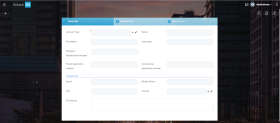Adding and Configuring Steps
Grouping entity information in steps based on specific criteria (business, operational or other relevant to you) is useful especially in complex financial activities when you have to display a lot of information on the entity forms and user journeys.
This sections walks you through the steps that you need to follow to add steps and configure them.
STEP 1. Add step
- On the configuration page of the form driven flow whose information you want to group in steps, click the Steps tab.
- At the top of the Entity Form Steps section, click the Insert button. The step configuration page appears, displaying only the general tab
- Provide the following fields:
Property Description Name The name of the step that will be used by system. NOTE A naming convention is an important part in a well-built data model; therefore, we recommend you to use PascalCaseNames (upper camel). The Name starts with an uppercase letter, as do all additional words.Display Name The name of the step. It is displayed in the Digital Experience Portal. 
- At the top-right corner of the page, click the Save and reload icon. The step configuration page appears, containing four tabs, displayed by default on the General tab. You can configure the step, by clicking the tabs and making the desired settings.
STEP 2. Design the step layout
Click the UI tab . You can design a complex form driven flow layout by providing the HMTL code or you can create a classic data form layout by using the HTML elements available on the toolbar of the HTML editor.
The step UI template supports the following tokens:
| Token | Description |
|---|---|
| {AttributeName} | Displays the corresponding field on the step. NOTE The attribute name must be included between curly brackets; otherwise, a simple text will be displayed on the page instead of the actual field. |
| {#RelationshipName, view: viewName#} | Generates a view provided by relationship and by view. The viewName is optional and specifies which view to generate. If viewName is not provided, the default view will be displayed on the data form. |
| {#RelationshipName, view: viewName, editmode:cell#} | Generates a view provided by relationship and by view. This view allows inline editing meaning that you can edit cells one by one directly in the grid, without opening specific records. NOTE In order to activate inline editing for a specific cell, you must tick the Allow Editing checkbox displayed on the entity view column (View > View columns). |
| {#MKT_CampaignResponse_MKT_Campaign,nodelete,noinsert#} | Generates a view provided by relationship and by view, but the Delete and Insert buttons are not displayed on the view. You can apply the same logic (similar tokens) for the Export (noexport) or Refresh (norefresh) if you no longer need them on the view. |
| {$ChartName$} | Generates a chart based on the provided chart name. |
| {? entityName, view: viewName ?} | Allows you to display a view from another entity. For information on how to use it, see Display View from Another Entity. |
Example of step UI template:

This is how a step might look like in the Portal UI:
In the HTML template, you can link HTML elements (labels) to attributes. For information on how to do it, see Link Labels to Attributes.
When designing the UI template of a step, you can also add custom buttons. For more information, see Create Custom Buttons.
STEP 3. Provide the code to be executed after the step is generated (optional)
Click the Advanced tab and in the After Events field, provide the code to be executed after the step is generated (opened).
In the upper-right corner of the page, click the Save and Close icon. The new section will be displayed in the Entity Form Sections list.
STEP 4. Define who has access to the step
If your business case requires that specific steps are available to designated roles within your organization, click the Security Roles tab and add the security roles who should have access to them. If no security roles are added here, all users will be able to view the section.
STEP 5. Save the step
At the top-right corner of the page, click the Save and close icon.
Add as many steps as you need, then either continue with the journey configuration or save the changes by clicking the Save and close icon.

